
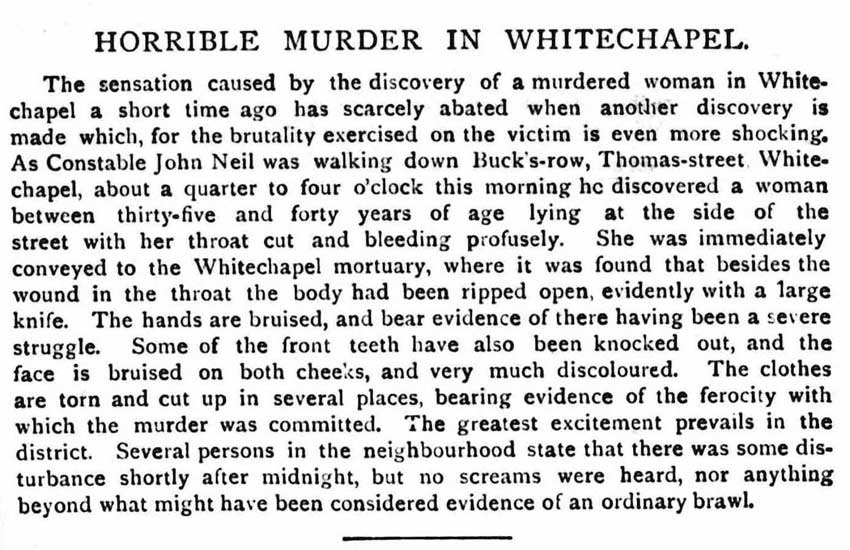


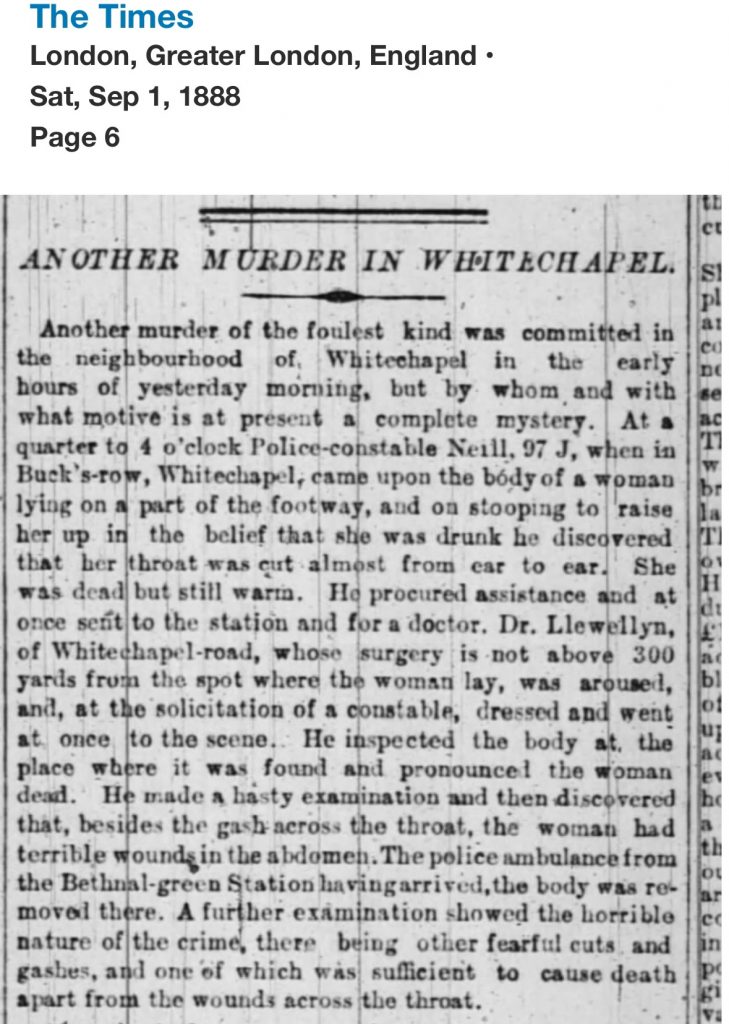

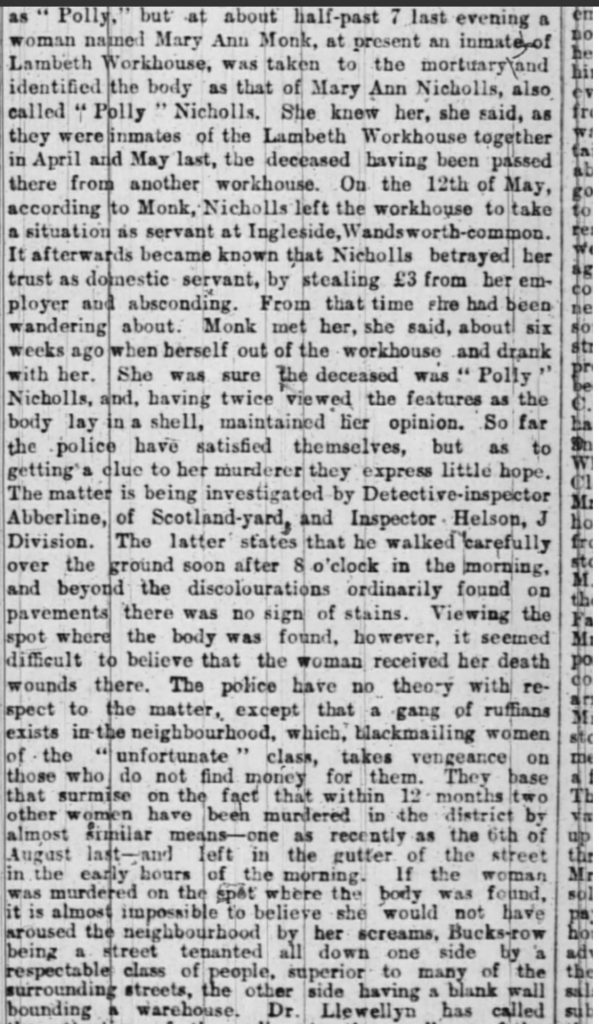

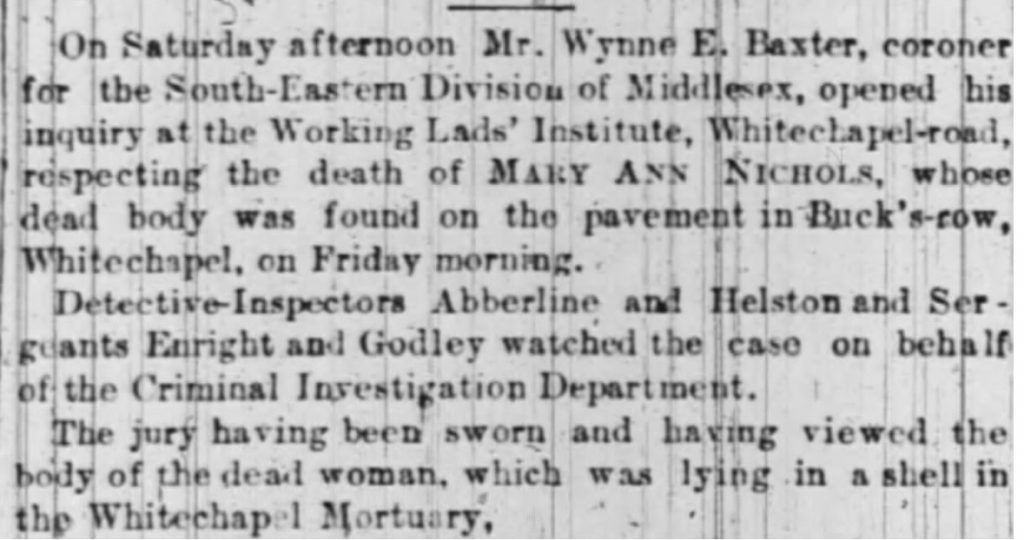

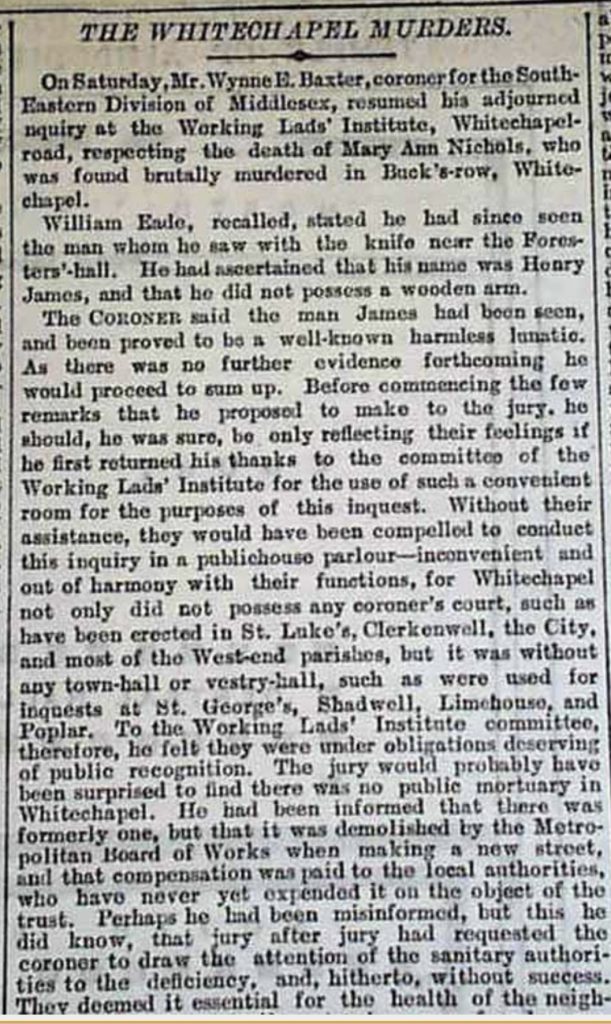
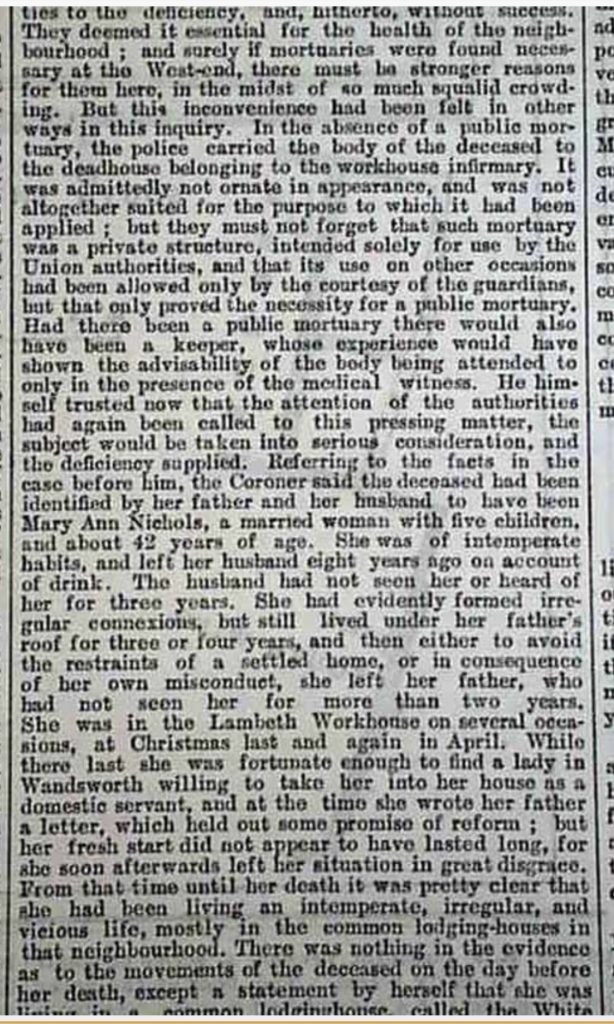

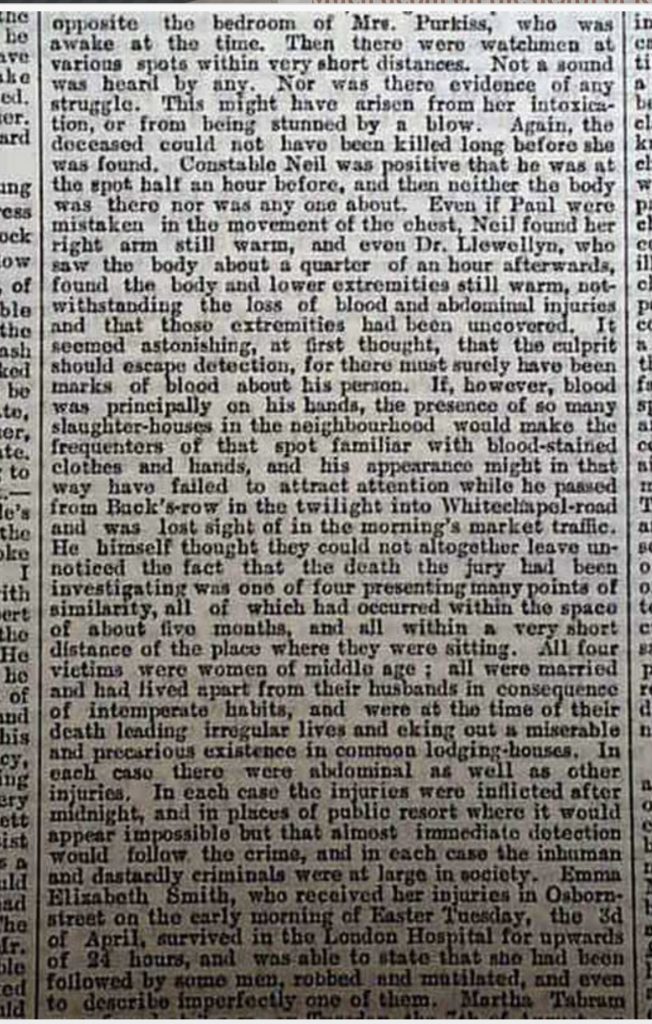


Den 24 augusti flyttar ”Polly” in på härbärget (där män och kvinnor får dela säng) The White House på 56 Flower and Dean St. Priset för en säng är 4 pence/natt. Så Polly är ganska ny i området.
Natten den 30 augusti rapporteras det om kraftigt regn samt åska och blixtar. Under natten brann det kraftigt av två bränder i hamnen.
Kvällen / morgonen 31 augusti
23.00 Polly syns vandra ner för Whitechapel Road.
00.30 Polly ses lämna the Frying Pan Public House vid Brick Lane och Thrawl Street. Hon går till sitt gamla härbärge Wilmott, på 18 Thrawl Street.
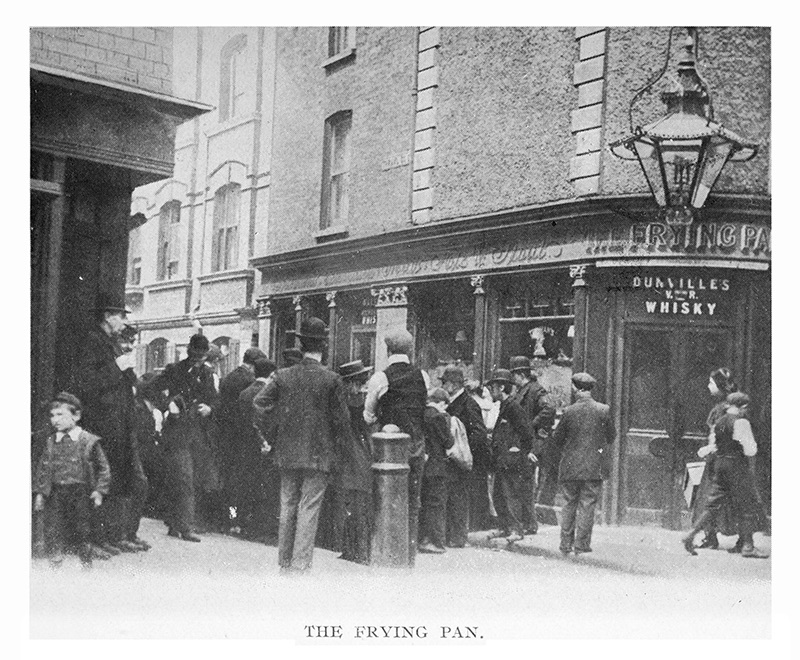
Runt 01.30 blir hon ombed att lämna då hon saknar pengar för en säng. Hon säger då ”Never Mind!” , ”I’ll soon get my doss money. See what a jolly bonnet I’ve got now.” Hon pratar om en ny hatt hon skaffat, som ingen tidigare sett henne ha.
02.30 Polly möter Emily Holland, som hade varit i hamnen och tittat på branden (the Shadwell Dry Dock fire). Emily säger sig möta Polly utanför en mataffär i hörnet av Whitechapel Road och Osborn Street. Polly kom gående ner för Osborn Street. Holland beskriver Polly som väldigt full och att hon behövde stå och luta sig mot väggen. Hon och Polly pratar med varandra mellan 7-10 minuter hävdar Holland. Holland försöker få med sig Polly tillbaks till härbärget (Wilmott). Holland jobbade på härbärget och trots att Polly blivit utsläng var det Holland som bestämde vilka som fick sova där eller ej. Polly tackar nej till hennes förslag utan säger hon ska skaffa sina pengar som hon gjort flera gånger under kvällen. Hon går sedan öster ut längs Whitechapel Road.

03.15 PC John Thain, 96J, går igenom Bucks Row under sitt skift. Han säger att inget speciellt fångade hans uppmärksamhet. Ungefär samma tid passerar Sergeant Kirby Bucks Row och rapporterar samma sak.
Före 3.30 Harriet Lilley boende två dörrar från mordet säger sig höra stön och flämtande ljud utanför sitt fönster. Hon säger sig höra röster men inte vad som sägs. Samtidigt som hon hörde detta passerade ett godståg förbi.
”a goods train passed on the East London Railway at about half-past three – the 3.7 out from New Cross”
Ca 03.40 hittar Charles Cross, en vagnförare för Pickfords, som var på väg till jobbet, kroppen av Polly. I mörkret trodde han först det var en pressening. Men han kom närmare såg han att det var en kvinna som låg där. Strax efter att han upptäckt kvinna kommer en annan man till platsen, Robert Paul, även han vagnsförare. Cross säger till Paul ”Come and look over here, there’s a woman.” Cross tror att kvinnan kan vara död. Hennes händer och ansikte är kalla. Robert hävdar att han känner hur hjärtat slår.
”I think she’s breathing,” säger han ”but it is little if she is.”
Båda mannen är sena till jobbet så dem rättar till Pollys kjol som är uppdragen och bestämmer sig för att berätta om kvinnan för nästa polis dem möter.
I hörnet av Hanbury Street och Baker’s Row möter dem PC Jonas Mizen och berättar för honom att : XXXX
03.45 Samtidigt som männen träffar polisen kommer PC John Neil, 97J tillbaks till Bucks Row och hittar Polly.
Han signalerar till PC Thain som sedan ansluter sig till honom och de två får snart sällskap av Mizen. Thain kallar på Dr. Rees Ralph Llewellyn, som bor i närheten. De återvänder några minuter senare (runt 03:50) och Dr. Llewellyn förklarar att hon har varit död ”bara några få minuter.”
Buck’s Row ligger tio minuters promenad från Osborn Street. Den enda belysningen kommer från en enda gaslampa i slutet av gatan.
Pollys kropp hittas mittemot Essex Wharf och Brown and Eagle Wool Warehouse och Schneiders Cap Factory, vid en portingång till Browns stallgård mellan en brädskola (västerut) och radhus (stugor) tillhörande bättre klassens hantverkare.
Hon ligger nästan under fönstret till Mrs. Emma Green, en lättväckt person, som bor i det första huset bredvid stallportarna. Hennes hus kallas ’New Cottage’. Hon är änka med två söner och en dotter som bor med henne. Den natten går en son och lägger sig klockan 21:00, den andra följer efter klockan 21:45. Mrs. Green och hennes dotter delade ett rum på första våningen längst fram i huset. De gick och la sig ungefär klockan 23:00. Hon påstår att hon sov ostört utan att höra något ovanligt ljud tills hon väcktes av polisen.
Mitt emot New Cottage bor Walter Purkiss, förvaltare av Essex Wharf, med sin fru, barn och tjänare. Han och hans fru gick och la sig klockan 23:00 respektive 23:15. Båda påstår att de var vakna vid olika tidpunkter under natten men hörde inget.
I lägenheten ovan Purkiss bor en nattvakt vid Schneiders Cap Factory, även han säger sig inget hört.
Men Harriet Lilley som bor bredvid Mrs Green säger sig hört röster på gatan samtidigt som godståget åkte förbi ca 03.35
Polly Nichols kropp identifieras av Lambeth Workhouse-inmate Mary Ann Monk och identifieringen bekräftas av William Nichols.
En inventering av hennes kläder görs av inspektör John Spratling på bårhuset. Hon hade på sig: (övergripande intryck – sjaskig och fläckig)
-Svart halmhatt dekorerad med svart sammet
-Rödbrun yllekappa med sju stora mässingsknappar med mönster av en kvinna på hästryggen åtföljd av en man.
-Brun Linsey klänning (till synes ny enligt Sugden. Kan detta vara en klänning hon stal från Cowdrys?)
-Vit flanell bröstduk
-Svarta ribbade yllestrumpor
-Två underkjolar, en grå ylle, en flanell. Båda stämplade på banden ”Lambeth Workhouse”
-Bruna stays (korta)
-Flanell underbyxor
Mans stövlar med ståltoppar på hälarna
Tillhörigheter:
-Kam
-Vitt näsduk
-Trasig bit av spegel (en högt värderad ägodel i en logi)
Observations of Dr. Rees Ralph Llewellyn upon arrival at Bucks row at 4:00 AM on the morning of August 31st. After only a brief examination of the body he pronounced Polly Nichols dead. He noted that there was a wine glass and a half of blood in the gutter at her side but claimed that he had no doubt that she had been killed where she lay.
Inquest testimony as reported in The Times:
”Five teeth were missing, and there was a slight laceration of the tongue. There was a bruise running along the lower part of the jaw on the right side of the face. That might have been caused by a blow from a fist or pressure from a thumb. There was a circular bruise on the left side of the face which also might have been inflicted by the pressure of the fingers. On the left side of the neck, about 1 in. below the jaw, there was an incision about 4 in. in length, and ran from a point immediately below the ear. On the same side, but an inch below, and commencing about 1 in. in front of it, was a circular incision, which terminated at a point about 3 in. below the right jaw. That incision completely severed all the tissues down to the vertebrae. The large vessels of the neck on both sides were severed. The incision was about 8 in. in length. the cuts must have been caused by a long-bladed knife, moderately sharp, and used with great violence. No blood was found on the breast, either of the body or the clothes. There were no injuries about the body until just about the lower part of the abdomen. Two or three inches from the left side was a wound running in a jagged manner. The wound was a very deep one, and the tissues were cut through. There were several incisions running across the abdomen. There were three or four similar cuts running downwards, on the right side, all of which had been caused by a knife which had been used violently and downwards. the injuries were form left to right and might have been done by a left handed person. All the injuries had been caused by the same instrument.”
Inspector Joseph Helson, J-division, is notified of the murder at 6.45am and at the mortuary he is shown the body and the extent of the mutilations.
With all of her faults Nichols seems to have been well-liked by all who knew her. At the inquest her father says, ”I don’t think she had any enemies, she was too good for that.”
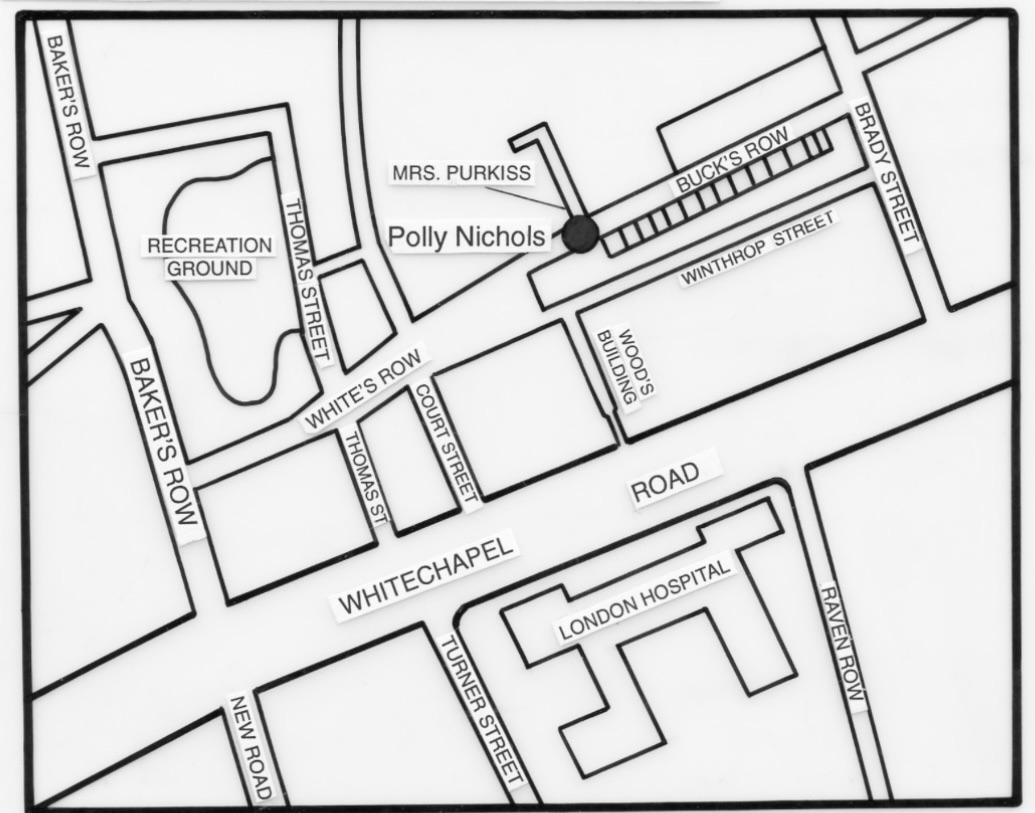

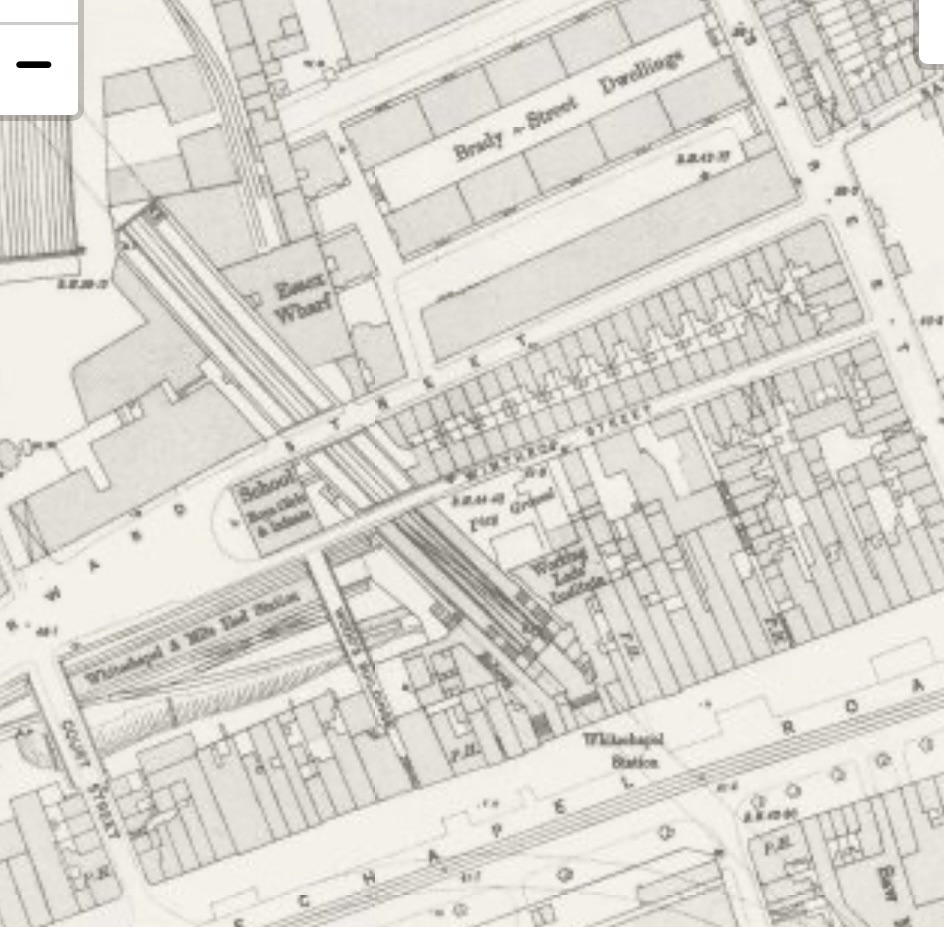
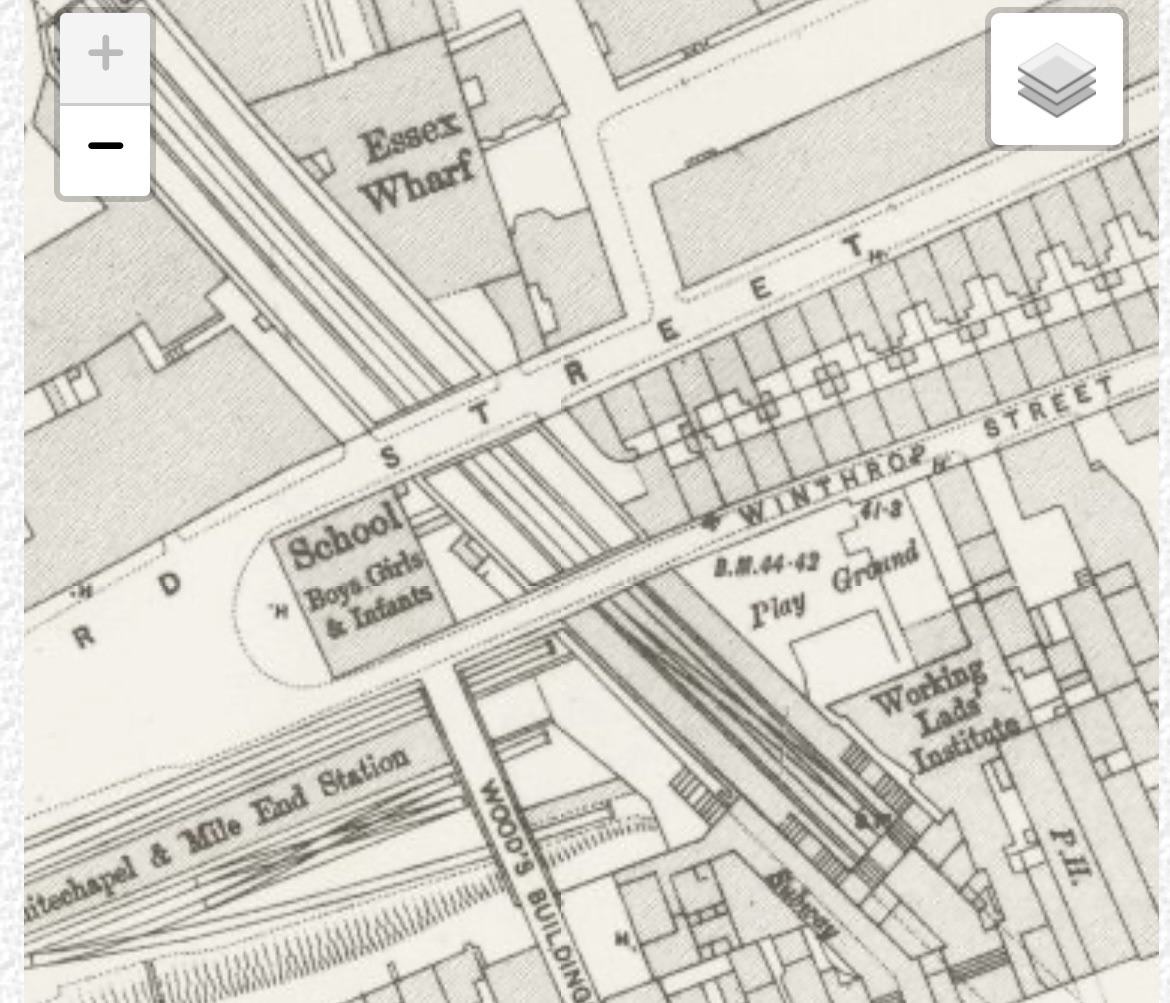
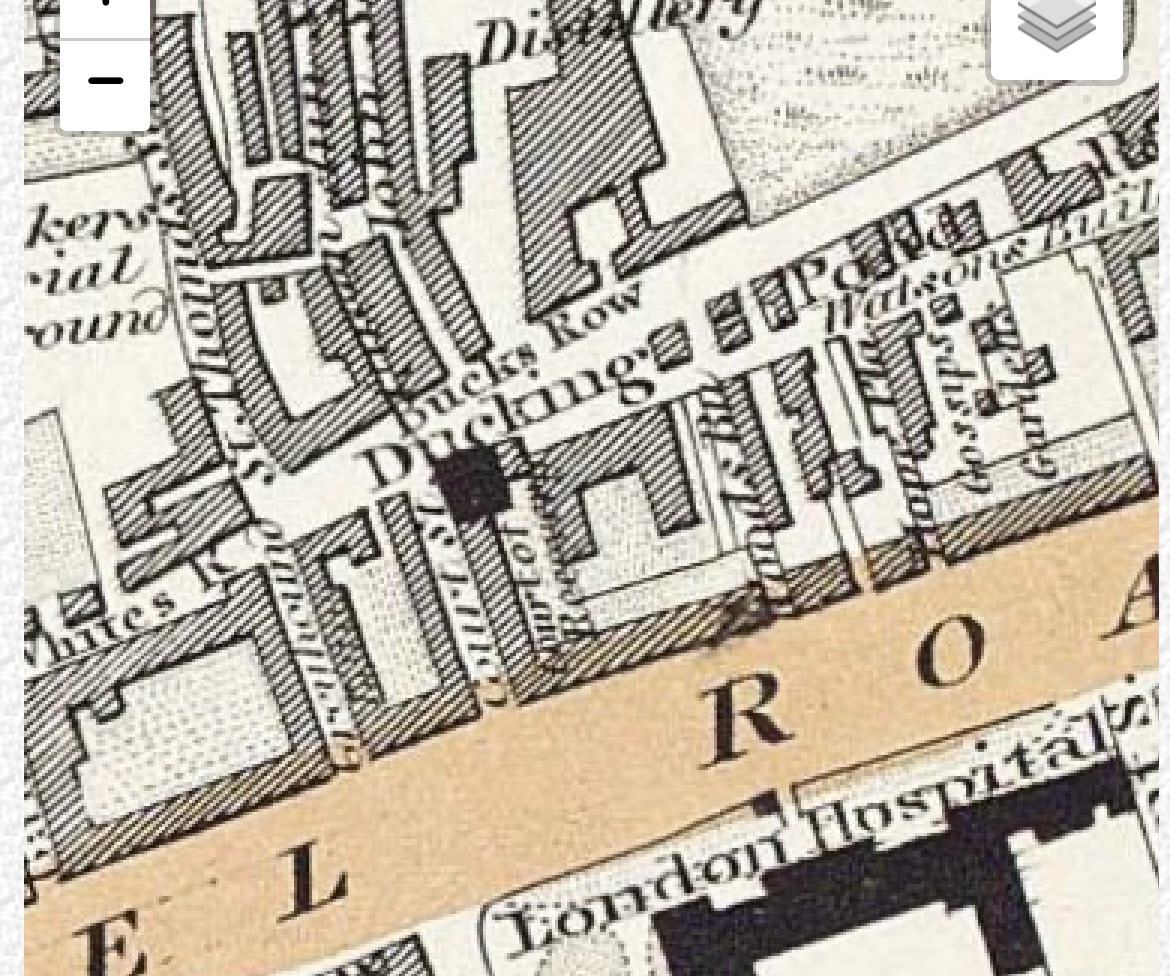


Mary Ann ’Polly’ Nichols
Born Mary Ann Walker on August 26, 1845 in Shoe Lane off Fleet Street. She was christened in or some years before 1851. At the time of her death the East London Observer guessed her age at 30-35. At the inquest her father said ”she was nearly 44 years of age, but it must be owned that she looked ten years younger.”
Features
5’2″ tall; brown eyes; dark complexion; brown hair turning grey; five front teeth missing (Rumbelow); two bottom-one top front (Fido), her teeth are slightly discoloured. She is described as having small, delicate features with high cheekbones and grey eyes. She has a small scar on her forehead from a childhood injury.
She is described by Emily Holland as ”a very clean woman who always seemed to keep to herself.” The doctor at the post mortem remarked on the cleanliness of her thighs. She is also an alcoholic.
History
Father: Edward Walker (Blacksmith, formerly a locksmith). He has gray hair and beard and, as a smithy, was probably powerfully built. At the time of Polly’s death he is living at 16 Maidswood Rd., Camberwell.
Mother: Caroline.
Polly married William Nichols on January 16, 1864. She would have been about 22 years old. The marriage is performed by Charles Marshall, Vicar of Saint Brides Parrish Church and witnessed by Seth George Havelly and Sarah Good.
William Nichols is in the employ of Messrs. Perkins, Bacon & Co., Whitefriars Rd. and living at Cogburg Rd. off Old Kent Road at the time of his wife’s death.
The couple have five children. Edward John, born 1866; Percy George, 1868; Alice Esther, 1870; Eliza Sarah, 1877 and Henry Alfred born in 1879. The oldest, 21 in 1888, is living with his grandfather (Polly’s father) at the time of her death. He had left home in 1880 according to his father, on his own accord. The other children continued to live with Nichols.
William and Polly briefly lodged in Bouverie Street then moved in with her father at 131 Trafalgar Street for about ten years. They spend six years, (no dates) at No. 6 D block, Peabody Buildings, Stamford Street, Blackfriars Rd. There they are paying a rent of 5 shillings, 6 pence per week. If Peabody Buildings is their last address then they would have lived there from 1875-1881, with her father from 1865 to 1875.
Polly separated from Nichols for the final time in 1881. It was the last of many separations during 24 years of marriage.
In 1882, William found out that his wife was living as a prostitute and discontinued support payments to her. (Sugden: she is living with another man, probably Thomas Dew). Parrish authorities tried to collect maintenance money from him. He countered that she had deserted him leaving him with the children. He won his case after establishing that she was living as a common prostitute. At the time of her death, he had not seen his wife in three years.
Polly’s father spread the story that the separation had come about due to William having an affair with the nurse who took care of Polly during her last confinement. William does not deny that he had an affair but states that it was not the cause of her leaving. ”The woman left me four or five times, if not six.” He claims that the affair took place after Polly left. There is obvious disharmony in the family as the eldest son would have nothing to due with his father at his mother’s funeral.
After the separation, Polly begins a sad litany of moving from workhouse to workhouse.
4/24/82-1/18/83 — Lambeth Workhouse
1/18/83-1/20/83 — Lambeth Infirmary
1/20/83-3/24/83 — Lambeth Workhouse
3/24/83-5/21/83 — She is living with her father in Camberwell. He testifies at the inquest into her death that she was ”a dissolute character and drunkard whom he knew would come to a bad end.” He found her not a sober person but not in the habit of staying out late at night. Her drinking caused friction and they argued. He claims that he had not thrown her out but she left the next morning.
5/21/83-6/2/83 — Lambeth Workhouse
6/2/83-10/26/87 — She is said to have been living with a man named Thomas Dew, a blacksmith, with a shop in York Mews, 15 York St., Walworth. In June 1886 she had attended the funeral of her brother who had been burned to death by the explosion of a paraffin lamp. It was remarked by the family that she was respectably dressed.
10/25/87 — She spends one day in St. Giles Workhouse, Endell Street.
10/26/87-12/2/87 — Strand Workhouse, Edmonton
12/2/87-12/19/87 — Lambeth Workhouse
On 12/2/87 It is said that she was caught ”sleeping rough (in the open)” in Trafalgar Square. She was found to be destitute and with no means of sustenance and was sent on to Lambeth Workhouse.
12/19/87-12/29/87 — Lambeth Workhouse
12/29/87-1/4/88 — No record
1/4/88-4/16/88 — Mitcham Workhouse, Holborn and Holborn Infirmary.
4/16/88-5/12/88 — Lambeth Workhouse. It is in Lambeth Workhouse that she meets Mary Ann Monk who will eventually identify Polly’s body for the police. Monk is described as a young woman with a ”Haughty air and flushed face.”
Polly has another friend in the Lambeth Workhouse, a Mrs. Scorer. She had been separated from her husband James Scorer, an assistant salesman in Spitalfields Market, for eleven years. He claimed that he knew Polly by sight but was unable to identify the body at the mortuary.
On 12 May she left Lambeth to take a position as a domestic servant in the home of Samuel and Sarah Cowdry. This was common practice at the time for Workhouses to find domestic employment for female inmates.
The Cowdry’s live at ”Ingleside”, Rose Hill Rd, Wandsworth. Samuel (b. 1827)is the Clerk of Works in the Police Department. Sarah is one year younger than her husband. They are described as upright people. Both are religious and both are teetotalers.
Polly writes her father:
”I just right to say you will be glad to know that I am settled in my new place, and going all right up to now. My people went out yesterday and have not returned, so I am left in charge. It is a grand place inside, with trees and gardens back and front. All has been newly done up. They are teetotalers and religious so I ought to get on. They are very nice people, and I have not too much to do. I hope you are all right and the boy has work. So good bye for the present.
from yours truly,
Polly
Answer soon, please, and let me know how you are.”
Walker replies to the letter but does not hear back.
She works for two months and then left while stealing clothing worth three pounds, ten shillings.
8/1/88-8/2/88 — Grays Inn Temporary Workhouse
Last Addresses
Common lodging house at 18 Thrawl Street, Spitalfields. Thrawl Street is south of and parallel to Flower and Dean Street. There she shares a room with four women including Emily (or Ellen) Holland. The room is described as being surprisingly neat. The price of the room is 4d per night.
Emily Holland is 50 years old. In October 1888 she has two convictions in Thames Magistrate Court for being drunk and disorderly.
On 8/24/88 Polly moves to a lodging house known as the White House at 56 Flower and Dean Street. In this doss house men are allowed to share a bed with a woman.
Flower and Dean Street held lodging houses in which Nichols, Stride and Eddowes lived at one time or another. Most of these common lodging houses catered to prostitutes. Flower and Dean is described in 1883 as ”perhaps the foulest and most dangerous street in the whole metropolis.” It and Thrawl Street are part of the area if Spitalfields known as the ”evil quarter mile.”
Thursday, August 30 through Friday, August 31, 1888.
Heavy rains have ushered out one of the coldest and wettest summers on record. On the night of August 30, the rain was sharp and frequent and was accompanied by peals of thunder and flashes of lightning. the sky on that night was turned red by the occasion of two dock fires.
11:00 PM — Polly is seen walking down Whitechapel Road, she is probably soliciting trade.
12:30 AM — She is seen leaving the Frying Pan Public House at the corner of Brick Lane and Thrawl Street. She returns to the lodging house at 18 Thrawl Street.
1:20 or 1:40 AM — She is told by the deputy to leave the kitchen of the lodging house because she could not produce her doss money. Polly, on leaving, asks him to save a bed for her. ” Never Mind!” She says, ”I’ll soon get my doss money. See what a jolly bonnet I’ve got now.” She indicates a little black bonnet which no one had seen before.
2:30 AM — She meets Emily Holland, who was returning from watching the Shadwell Dry Dock fire, outside of a grocer’s shop on the corner of Whitechapel Road and Osborn Street. Polly had come down Osborn Street. Holland describes her as ”very drunk and staggered against the wall.” Holland calls attention to the church clock striking 2:30. Polly tells Emily that she had had her doss money three times that day and had drunk it away. She says she will return to Flower and Dean Street where she could share a bed with a man after one more attempt to find trade. ”I’ve had my doss money three times today and spent it.” She says, ”It won’t be long before I’m back.” The two women talk for seven or eight minutes. Polly leaves walking east down Whitechapel Road.
At the time, the services of a destitute prostitute like Polly Nichols could be had for 2 or 3 pence or a stale loaf of bread. 3 pence was the going rate as that was the price of a large glass of gin.
3:15 AM — P.C. John Thain, 96J, passes down Buck’s Row on his beat. He sees nothing unusual. At approximately the same time Sgt. Kerby passes down Bucks Row and reports the same.
3:40 or 3:45 AM — Polly Nichols’ body is discovered in Buck’s Row by Charles Cross, a carman, on his way to work at Pickfords in the City Road., and Robert Paul who joins him at his request. ”Come and look over here, there’s a woman.” Cross calls to Paul. Cross believes she is dead. Her hands and face are cold but the arms above the elbow and legs are still warm. Paul believes he feels a faint heartbeat. ”I think she’s breathing,” he says ”but it is little if she is.”
P.C. Neil
Dr. Llewellyn
P.C. Neil is called by the two men and rushes over to the scene of the crime. Neil, in turn, calls for Dr. Llewellyn, who resides nearby. The two return a few minutes later (around 3:50 A.M.) and Dr. Llewellyn pronounces life to have been extinct ”but a few minutes.”
Bucks Row is ten minutes walk from Osborn Street. The only illumination is from a single gas lamp at the far end of the street.
Buck’s Row:
Description by Leonard Matters in 1929
”…Buck’s Row can not have changed much in character since its name was altered. It is a narrow, cobbled, mean street, having on one side the same houses-possibly tenanted by the same people — which stood there in 1888. They are shabby, dirty little houses of two stories, and only a three foot pavement separates them from the road, which is no more than twenty feet from wall to wall.
On the opposite sides are the high walls of warehouses which at night would shadow the dirty street in a far deeper gloom than its own character would in broad day light suggests.
All Durward Street is not so drab and mean, for by some accident in the planning of the locality — if ever it was planned — quite two thirds of the thoroughfare is very wide and open.
The street lies east and west along the London and Northern Railway Line. It is approached from the west by Vallance Street, formerly Baker’s Row. On the left are fine modern tall warehouses. I was interested to note that one of them belongs to Messrs. Kearly and Tongue, LTD. in front of whose premises in Mitre Square another murder was committed on September 30th. On the left side of the street is a small wall guarding the railway line, which lies at a depth of some twenty feet below ground level. Two narrow bridge roads lead across the railway to Whitechapel Road. The first was called Thomas Street in 1888, but now is Fullbourne Street. The other is Court Street. By either of these two lanes, no more that two hundred fifty yards long, the busy main artery of the Whitechapel area can be reached from the relatively secluded Buck’s Row.
Going still further east, an abandoned London County Council School building breaks the wide and open Durward Street into narrow lanes or alleys. The left hand land retains the name of Durward Street ’late Buck’s Row’, and the other is Winthrop Street. Both are equally dirty and seemingly disreputable…”
Soon after the murder, to avoid continued notoriety, the name is changed from Buck’s Row to Durward Street.
The discovery of the body.
Polly’s body is found across from Essex Wharf (warehouse) and Brown and Eagle Wool Warehouse and Schneiders Cap Factory in a gateway entrance to an old stableyard between a board school (to the west) and terrace houses (cottages) belonging to better class tradesmen. She is almost underneath the window of Mrs. Green, a light sleeper, who lives in the first house next to the stable gates. Her house is called the ’New Cottage’. She is a widower with two sons and a daughter living with her. That night, one son goes to bed at 9:00 PM, the other follows at 9:45. Mrs. Green and her daughter shared a first floor room at the front of the house. They went to bed at appoximately 11:00 PM. She claims she slept undisturbed by any unusual sound until she was awakened by the police.
Opposite New Cottage lives Walter Purkiss, the manager of Essek Wharf with his wife, children and a servant. He and his wife went to bed at 11:00 and 11:15 respectively. Both claimed to have been awake at various times in the night and heard nothing.
Polly Nichols’ body is identified by Lambeth Workhouse inmate Mary Ann Monk and the identification confirmed by William Nichols.
She was wearing: (overall impression — shabby and stained)
Illustration from the Illustrated Police News
Black Straw bonnet trimmed with black velvet
Reddish brown ulster with seven large brass buttons bearing the pattern of a woman on horseback accompanied by a man.
Brown linsey frock (apparently new according to Sugden. Could this be a dress she stole from the Cowdrys?)
White flannel chest cloth
Black ribbed wool stockings
Two petticoats, one gray wool, one flannel. Both stenciled on bands ”Lambeth Workhouse”
Brown stays (short)
Flannel drawers
Men’s elastic (spring) sided boots with the uppers cut and steel tips on the heels
Possessions:
Comb
White pocket handkerchief
Broken piece of mirror (a prized possession in a lodging house)
Observations of Dr. Rees Ralph LLewellyn upon arrival at Bucks row at 4:00 AM on the morning of August 31st. After only a brief examination of the body he pronounced Polly Nichols dead. He noted that there was a wine glass and a half of blood in the gutter at her side but claimed that he had no doubt that she had been killed where she lay.
Inquest testimony as reported in The Times:
Mortuary photograph of Polly Nichols
”Five teeth were missing, and there was a slight laceration of the tongue. There was a bruise running along the lower part of the jaw on the right side of the face. That might have been caused by a blow from a fist or pressure from a thumb. There was a circular bruise on the left side of the face which also might have been inflicted by the pressure of the fingers. On the left side of the neck, about 1 in. below the jaw, there was an incision about 4 in. in length, and ran from a point immediately below the ear. On the same side, but an inch below, and commencing about 1 in. in front of it, was a circular incision, which terminated at a point about 3 in. below the right jaw. That incision completely severed all the tissues down to the vertebrae. The large vessels of the neck on both sides were severed. The incision was about 8 in. in length. the cuts must have been caused by a long-bladed knife, moderately sharp, and used with great violence. No blood was found on the breast, either of the body or the clothes. There were no injuries about the body until just about the lower part of the abdomen. Two or three inches from the left side was a wound running in a jagged manner. The wound was a very deep one, and the tissues were cut through. There were several incisions running across the abdomen. There were three or four similar cuts running downwards, on the right side, all of which had been caused by a knife which had been used violently and downwards. the injuries were form left to right and might have been done by a left handed person. All the injuries had been caused by the same instrument.”
With all of her faults she seems to have been well liked by all who knew her. At the inquest her father says, ”I don’t think she had any enemies, she was too good for that.”
- Lechmere sees something lying on the opposite side of the street, which he, at first, thinks might be a tarpaulin sheet. Then, while crossing the street, he sees it’s the figure of a woman.
- He then hears someone coming. This someone is, of course, Paul.
- Lechmere waits for Paul and together they walk over to the body.
- They examine the body shortly and then leave it in search of a copper.
- Paul & Lechmere arrive at where Mizen is (the end of Hanbury Street).
- At around the same time Neil discovers the body.
- Very shortly afterwards Neil hears Thain pass Brady Street and flags him down with his lantern.
- Thain arrives at crime spot, where he sees the body and Neil immediately sends him for the doctor.
- Some short time after Thain has left, Neil spots Mizen and flags him down with his lantern, as well.
- Shortly afterwards Mizen arrives at crime spot and Neil sends him immediately for the ambulance at the Bethnal Green station, some 920 meters away from the crime scene.
- Thain arrives at the doctor’s.
- Sergeant Kirby arrives and one or two other constables. And two or three (work)men arrive, too.
- Neil rings the bell at Essex Wharf and Walter Purkiss opens a window. He’s able to see the deceased and that there are two or three men there besides three or four constables.
- About the same time St. Kirby knocks at Mrs. Green door and she also opens her window. She, too, sees the body of deceased lying on the ground and three or four constables and two or three other men.
- Thain returns with doctor Llewellyn.
- Thain receives orders to remain at the spot to wait for Spratling after the body will have been removed.
- Because Thain doesn’t know how long he has to wait for Spratling and before Nichols is moved to the mortuary in Pavillion Yard, Thain goes to the slaughterhouse in Winthrop Street to fetch his cape and tells the men there’s a woman murdered in Buck’s Row.
- In this same period (from Thain returning with the doctor to him going to the slaughterhouse) Mizen returns with the ambulance.
- Two of the 3 slaughtermen go to the crime spot and remain there until the body of Nichols is removed and taken to the mortuary in Pavilion Yard. They remain some 10 minutes.
- After a man passes Mulshaw and tells him he believes a woman is murdered in the street, Mulshaw also goes to have a look. He sees the body of deceased lying on the ground and three or four policemen and five or six working men standing around it.
- The body is put on the ambulance by Thain and another constable and carried away by Neil, Kirby and Mizen.
- Around this same point Inspector Spratling receives information about the murder when in Hackney Road, over 1 km from the crime spot. He first goes to the station and then to Buck’s Row.
- The son of Mrs. Green washes the blood away with a pail of water with Thain present.
- Spratling arrives at the scene and is shown by Thain where the body had lain.
- Spratling then goes to the mortuary and finds the body on an ambulance in the yard. It had been placed there because the keys, which had been sent for, had not yet arrived.
- While waiting, Spratling takes a description of the dead woman.
- Robert Mann arrives with the keys, after which the body is put on the floor of the mortuary.
- Spratling discovers the injuries to the abdomen, and he sends for Dr. Llewellyn.
- Dr. Llewellyn is summoned to the mortuary to see about the abdominal wounds.
- Dr. Llewellyn arrives at the mortuary and makes an examination lasting about ten minutes or a quarter of an hour.

Evening Standard (London) 1 September 1888
Buck’s row runs through from Thomas street to Brady street, and in the latter street what appeared to be blood stains were early in the morning found at irregular distances on the footpaths on each side of the street. Occasionally a larger splash was visible, and from the way in which the marks were scattered it seems as though the person carrying the mutilated body had hesitated where to deposit his ghastly burden, and had gone from one side of the road to the other, until the obscurity of Buck’s row afforded the shelter sought for. The street had been crossed twice within the space of about 120 yards. The point at which the stains were first visible is in front of the gateway to Honey’s mews, in Brady street, about 150 yards from the point where Buck’s row commences.
Several persons living in Brady street state that early in the morning they heard screams, but this is by no means an uncommon incident in the neighbourhood; and with one exception nobody seems to have paid any particular attention to what was probably the death struggle of an unfortunate woman. The exception was a Mrs. Colville, who lives only a short distance from the foot of Buck’s row. According to her statement she was awakened early in the morning by her children, who said someone was trying to get into the house. She listened and heard a woman screaming ”Murder! police!” five or six times. The voice faded away as though the was going in the direction of Buck’s row, and all was quiet. She only heard the steps of one person.
Or this:
LLOYD’S WEEKLY NEWSPAPER LONDON: SUNDAY, SEPT. 2, 1888.
A LITTLE GIRL’S STORY.
Charlotte Colville, who lives about the middle of Brady-street, made the following statement to our representative on Friday night :- I am 11 years of age, and sleep with my mother. Early this (Friday) morning, before it was light, I heard terrible cries of ”Murder! Murder! Police! Police! Murder!” They seemed a good way down Brady-street to the right, where the marks of bloody hands are. Then the sounds came up the street towards our house, and I heard a scuffling and a bumping against our shutters. I got out of bed and woke my mother. The woman kept on calling out ”Murder! Police!” and the sounds went on in the direction of Buck’s-row, where the body was found. I am sure the first sounds seemed to come from where the blood-stains of hands are on the wall.
Mrs. Colville said that her little girl woke her, and she heard the woman’s cries, but the rows go on every night, and people are constantly being knocked down and robbed by the fearful gangs about. It would not be safe for anyone to get out of their beds to go and interfere. People have done so, and only been terribly ill-treated.
The above report was backed up by this:
LLOYD’S WEEKLY NEWSPAPER LONDON: SUNDAY, SEPT. 2, 1888.
1 September 1888 The people living in Brady-street were thrown into a state of excitement on the terrible news spreading. Brady-street is a long thoroughfare that runs to the left from the bottom of Buck’s-row. Early on Friday morning fresh blood stains were observed for quite a distance along the side walks. There would be drop after drop two or three feet, and sometimes six feet apart for a distance, and then a larger pool or splash. As soon as the murder became known a lively interest was taken in these blood-stains, and they began to be traced. They were soon found to be on both sides of the street, and it was afterwards seen that the bleeding person had travelled or been carried in a zig-zag line. The trail was easily followed down Brady-street for 150 yards to Honey’s-mews. In front of the gateway there was a large stain, looking as if the bleeding person had fallen against the wall and lain there. From here to the foot of Buck’s-row, in which the body was found, the trail of blood was clearly marked. It was wet on Friday morning, and at noon, although the sun had dried it, and there had been many feet passing over it, it was still plainly discernible. The zig-zag direction it took crossing and re-crossing the street was and is a matter of mystery. In the space of a hundred yards the woman crossed the narrow street twice, and whenever she crossed a larger stain of blood in place of the drops indicated that she had stopped.
Our representative discovered, however, on making inquiries the same night, that at a house near where the blood spots were, a man, early on the morning of the tragedy, had made a murderous assault on his wife and cut her throat. She was carried to the London hospital, and it is very probable some blood dripped from her.
I’m sure that a murderer did not drag/carry Polly from Brady St to Buck’s Row, but the rest of the story seems to indicate that something did happen earlier that night (and with an all too familiar response, – ‘Several persons living in Brady street state that early in the morning they heard screams, but this is by no means an uncommon incident in the neighbourhood.’
I’m sure that I have read somewhere that police did respond, and the bloodstains dropped from the ambulance used to take the victim either to hospital or the mortuary. Unfortunately, in my dotage, I can’t remember where I did see this.
At one point I did think that the last part of the above report referred to Henry Hummerstone’s attempted murder of his wife, but this took place after the event as his statement – ‘I’m going to do a Buck’s Row job on you’ shows. So at this point I am back to my original hypothesis.
However, as further support for this, I found this news report in my files.
East London Observer Saturday, 1 September 1888.
ANOTHER HORRIBLE TRAGEDY IN WHITECHAPEL.
A Woman Murdered in Buck’s Row.
TERRIBLE DETAILS.
Latest Particulars.
While the George-yard horror in all its sickening and revolting details is still before the minds of the people of Whitechapel, there has just been acted in the same district another tragedy, which bids fair not only to equal that of George-yard, for the horrible manner in which the victim has met her death, but also for the mystery which seems to surround the manner in which she was murdered, and, indeed her whole history.
It seems that on Friday morning Police-constable Neale [Neil], 97 J, was on his beat at about half-past four, in the neighbourhood of Buck’s-row. It was then just after half-past four, and, in the early light of day he discovered lying on the pavement just outside the high brick wall which surrounds the Essex Wharf, the form of a woman. She was lying on her back, with hands that were tightly clenched, and presenting altogether the appearance of one who had died in the greatest agony. She was wearing a little black straw bonnet, battered almost out of recognition, and placed at the back of her head. Around her was a cloak – a threadbare garment that had once been red, but was now a dull, dirty colour. It was open in front, and the black bodice of her dress was thrown slightly open, revealing a horrible gash more than an inch in diameter, extending from one ear to the other, and completely severing the windpipe, which protruded from the deep wound. Constable Neale at once called for assistance, and with the help of some scavengers who were cleaning the roads at the time, managed to carry the body to the mortuary, which is situated in the Pavilion Yard close by. Mr. Edmunds, the keeper of the mortuary, was in attendance, and assisted by the officer and the scavengers, undressed the poor creature and placed her in one of the black coffins lying about the mortuary.
In the Dead-House.
The news of the terrible tragedy spread like wild-fire amongst the inhabitants of Buck’s-row and the neighbourhood, who, filled with morbid curiosity, surrounded Eagle-place, the entrance by which the body was taken into the dead-house. The Whitechapel Mortuary is a little brick building situated to the right of the large yard used by the Board of Works for the storage of their material. Accompanied by Mr. Edmunds, the keeper, our reporter visited the temporary resting place of the victim on Friday morning. The first evidence seen of the tragedy on arriving in the yard was a bundle of what were little more than rags, of which the woman had been divested, and which were lying on the flagstones just outside the mortuary. They consisted of a dull red cloak already mentioned, together with a dark bodice and brown skirt, a check flannel petticoat which bore the mark of the Lambeth Workhouse, a pair of dark stockings, and an old pair of dilapidated-looking spring-side boots, together with the little and sadly battered black straw bonnet, minus either ribbons or trimmings. Contrary to anticipation, beyond the flannel petticoat, and with the exception of a few bloodstains on the cloak, the other clothing was scarcely marked. The petticoat, however, was completely saturated with blood, and altogether presented a sickening spectacle. Entering the deadhouse, with its rows of black coffins, the keeper turned to the one immediately to the right of the door, and lying parallel with the wall. Opening the lid, he exposed the face of the poor victim. The features were apparently those of a woman of about thirty or thirty-five years, whose hair was still dark. The features were small and delicate, the cheek-bones high, the eyes grey, and the partly opened mouth disclosed a set of teeth which were a little discoloured. The expression on the face was a deeply painful one, and was evidently the result of an agonizing death. The gash across the neck was situated very slightly above the breastbone; it was at least six inches in length, over an inch in width, and was clean cut. The hands were still tightly clenched. The lower portion of the body, however, presented the most sickening spectacle of all. Commencing from the lower portion of the abdomen, a terrible gash extended nearly as far as the diaphragm – a gash from which the bowels protruded. There were no rings upon the fingers, and no distinguishing marks either about the face or the body.
The body, with the exception of the face was covered with a white sheet and a blanket.
Who is the Victim?
Inspector Helson, of Leman-street, had called earlier, and had taken a description of the woman, together with a list of the articles of clothing. On finding the Lambeth Workhouse mark, he immediately proceeded there, but, up to the time of going to Press, he had not gleaned any authoritative information regarding the identity of the woman. She was unknown either to Police-constable Neale, or any of the officials, as a frequenter of the neighbourhood, and altogether the identity like that of the victim of the George-yard tragedy, seems likely for a time to be shrouded in mystery. Several people who were waiting outside the mortuary claimed to have had friends or acquaintances missing, but when put to the test, the descriptions failed to tally with that of the murdered woman.
Who was the Murderer?
There is absolutely no room for doubt that the woman has been the victim of a foul crime. It might have been within the bounds of possibility for a woman to have inflicted the wound across the throat, but the terrible abdominal wound could never have been self-inflicted. Moreover, the wound in the throat, which was evidently the first inflicted, was quite sufficient of itself to have caused almost immediate death. But, while there is, as we have said, but little doubt as to the woman having been murdered, there seems to be but little motive for the murder. Robbery was certainly not the motive, for the victim appears to have been in extreme poverty. Like poor Martha Tabram, of George-yard, then, the poor ”unknown” appears to have been the victim of some fiend. Indeed, the inhabitants of Buck’s-row, among whom the murder was the sole topic of conversation on Friday morning, go so far as to assert that the very similar manner in which both the victims have met their death – both in the dead of night, both with wounds of a most revolting character, and both without any apparent motive – point to the murderer of Martha Tabram having been the murderer also of the poor unknown of Buck’s-row. Near the scene of the murder are the Essex Wharf and several private houses, mostly inhabited by the poorer classes, who have either come home very late at night, or have to go out very early in the morning, and yet nobody appears to have been aware of having heard any screaming or other sounds likely to fix the time at which the tragedy was perpetrated – probably judging from the appearance of the dead woman at the time she was found, about two or three o’clock on the Friday morning. The probability is that although the victim did scream, yet, so used are the inhabitants there to drunken brawls and cries of ”Murder,” that they took no notice of it, and that the murderer, whoever he is, thus escaped undetected.
Mr. Banks, the coroner’s officer, viewed the body early on Friday and communicated the particulars to Mr. George Collier, the coroner, who will probably hold the inquest some time to-day (Saturday).
LATEST DETAILS.
A more minute examination of the body shows the height of the victim to be five feet two inches. The hands are bruised and bear evidence of having engaged in a severe struggle. There is the impression of a ring having been worn on one of the deceased’s fingers, but there is nothing to show that it had been wrenched from her in a struggle. Some of the teeth appear to have been knocked out, and the face is bruised on both cheeks, and slightly discoloured. People living near the scene of the murder all concur in saying that they heard no screaming at about the time of the murder. Mrs. Purkiss, who lives in Essex Wharf, states that although she was suffering from extreme nervousness, and failed to sleep during the night, yet she heard nothing to attract her attention.
The wounds seem to have been inflicted with a large pocket knife.
—-
New York Times September 1st
”London Aug. 31. A strangely horrible murder took place at Whitechapel this morning. The victim was a woman who, at 3 o’clock was knocked down by some man unknown and attacked with a knife. She attempted to escape and ran a hundred yards, her cries for help being heard by several persons in adjacent houses. No attention was paid to her cries however, and when found at daybreak she was lying dead in another street, several hundred yards from the scene of the attack…”
——-
Alan Sharp had spoken of it in his book back in 2005.
Buck’s row, where the body was found, is a narrow passage running out of Thomas-street, and contains a dozen houses of very low class. When Police constable Neil discovered the body he roused people living in the house immediately opposite where the body was found, but none of them had heard any sounds of struggle. Several persons living on Brady-street state that early in the morning they heard screams, but this is by no means an uncommon incident in the neighbourhood, and with one exception nobody seems to have paid any particular attention to what was probably the death struggle of an unfortunate woman. The exception was a Mrs. Colville, who lives only a short distance from the foot of Buck’s-row. She says she was awakened in the morning by a woman screaming ”Murder! police!” five or six times. The voice faded away as though the woman was going in the direction of Buck’s-row, and all was quiet. She only heard the steps of one person. Inspector (Helson) has, however since stated that neither blood-stains nor wheel marks were found to indicate that the body had been deposited where found, and himself and Inspector Abberline had come to the conclusion that it was committed on the spot.
——-
Timeline events
- Lechmere sees something lying on the opposite side of the street, which he, at first, thinks might be a tarpaulin sheet. Then, while crossing the street, he sees it’s the figure of a woman.
- He then hears someone coming. This someone is, of course, Paul.
- Lechmere waits for Paul and together they walk over to the body.
- They examine the body shortly and then leave it in search of a copper.
- Paul & Lechmere arrive at where Mizen is (the end of Hanbury Street).
- At around the same time Neil discovers the body.
- Very shortly afterwards Neil hears Thain pass Brady Street and flags him down with his lantern.
- Thain arrives at crime spot, where he sees the body and Neil immediately sends him for the doctor.
- Some short time after Thain has left, Neil spots Mizen and flags him down with his lantern, as well.
- Shortly afterwards Mizen arrives at crime spot and Neil sends him immediately for the ambulance at the Bethnal Green station, some 920 meters away from the crime scene.
- Thain arrives at the doctor’s.
- Sergeant Kirby arrives and one or two other constables. And two or three (work)men arrive, too.
- Neil rings the bell at Essex Wharf and Walter Purkiss opens a window. He’s able to see the deceased and that there are two or three men there besides three or four constables.
- About the same time St. Kirby knocks at Mrs. Green door and she also opens her window. She, too, sees the body of deceased lying on the ground and three or four constables and two or three other men.
- Thain returns with doctor Llewellyn.
- Thain receives orders to remain at the spot to wait for Spratling after the body will have been removed.
- Because Thain doesn’t know how long he has to wait for Spratling and before Nichols is moved to the mortuary in Pavillion Yard, Thain goes to the slaughterhouse in Winthrop Street to fetch his cape and tells the men there’s a woman murdered in Buck’s Row.
- In this same period (from Thain returning with the doctor to him going to the slaughterhouse) Mizen returns with the ambulance.
- Two of the 3 slaughtermen go to the crime spot and remain there until the body of Nichols is removed and taken to the mortuary in Pavilion Yard. They remain some 10 minutes.
- After a man passes Mulshaw and tells him he believes a woman is murdered in the street, Mulshaw also goes to have a look. He sees the body of deceased lying on the ground and three or four policemen and five or six working men standing around it.
- The body is put on the ambulance by Thain and another constable and carried away by Neil, Kirby and Mizen.
- Around this same point Inspector Spratling receives information about the murder when in Hackney Road, over 1 km from the crime spot. He first goes to the station and then to Buck’s Row.
- The son of Mrs. Green washes the blood away with a pail of water with Thain present.
- Spratling arrives at the scene and is shown by Thain where the body had lain.
- Spratling then goes to the mortuary and finds the body on an ambulance in the yard. It had been placed there because the keys, which had been sent for, had not yet arrived.
- While waiting, Spratling takes a description of the dead woman.
- Robert Mann arrives with the keys, after which the body is put on the floor of the mortuary.
- Spratling discovers the injuries to the abdomen, and he sends for Dr. Llewellyn.
- Dr. Llewellyn is summoned to the mortuary to see about the abdominal wounds.
- Dr. Llewellyn arrives at the mortuary and makes an examination lasting about ten minutes or a quarter of an hour.
- The only thing that I notice missing is that while Dr Lewellyn was examining the body, an unknown man passed down Buck’s Row. The coroner asked the police about that man during in inquest, but they had not found him. Since the coroner didn’t ask about the other men who came to the crime scene, that implies that those other men were identified by the police. We should also consider that this unknown man might have been the man who told Patrick Mulshaw of the murder.